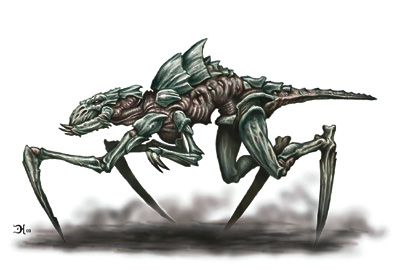![]()
 Countless first adventures of D&D over the years and throughout the editions have shared the common trait of fighting the same sorts of savage humanoid monsters: typically kobolds, goblins, or orcs.
Countless first adventures of D&D over the years and throughout the editions have shared the common trait of fighting the same sorts of savage humanoid monsters: typically kobolds, goblins, or orcs.
Even the 4e DMG loyally continues this tradition with the mini-adventure Kobold Hall, which despite a familiar foe, serves its purpose as a good introduction to the D&D 4e game.
However, to do something different to wake up your regular gaming group or to simply stay away from the cliche low-level monsters – but save a lot of time and not create a whole new adventure from scratch – try re-skinning starter adventures like Kobold Hall, the DM’s Kit’s Reavers of Harkenwold, or any of the low level ones in Dungeon Delve.
First, skip the whole savage humanoids category altogether, just so the party faces something different to kick off the campaign. Pick a different monstrous grouping or monster type that you haven’t played around with in a while – either as DM or as a playgroup or both. Perhaps some lore in Monster Vault is truly compelling or some artwork in any of the monster manuals really captures you or your friends’ imagination.
Poll your players in person or online for their favorite monsters – everyone has something they’ve always loved fighting in D&D! Or better yet, learn and share what monster either you or your DM has always wanted to run, or a monster a player has always wanted to fight, but never got the chance.
For extra theme, flavor or “strangeness,” work in planar or “sci-fi”-feel threats – monsters, terrain features, or NPC power groups, for example – early instead of later for a change of pace. Choose a sourcebook with material everyone’s excited about or would enforce that theme, such as Heroes of Shadow, Heroes of the Feywild, The Plane Below or the Underdark. D&D 3rd edition had a few thematic sourcebooks for related inspiration here as well, such as the Frostburn, Stormwrack and Sandstorm environmental series.
Use these fantastic locations and environs as inspiration for making any changes to your starter adventure’s encounter areas or environment – and only if you need these changes to better tell the story and fit the ecology of the creatures lairing or frequenting there. If a ruined manor or cavern still works thematically, keep it. If an ancient pyramid or large sunken ship with plenty of air pockets fits better, then that’s what it becomes – but keep the same general “room” sizes and encounter areas. For example, your re-skinned Kobold Hall might be a pyramid, surrounded by scorching, quicksand-filled sand dunes and teeming with all manner of serpents, lizards, and baby basilisks both inside and outside the pyramid walls.
Pulling all these ideas together, check out the lore on the insectoid Kruthiks. There’s a story there that could span an entire tier of play or campaign, ripe with adventure hooks and a variety of potentially thematic monsters. A monster mix is always good though, so that there’s multiple ways to approach encounters beyond “kill everything.” Alternate encounter options and goals, like negotiation, defense, escorts, etc. keep the encounter and monster experiences varied and fresh.
Now take Kobold Hall or whatever starter adventure you like or have used before, and re-imagine it with these new monsters and themes included, making simple substitutions – i.e. kobolds become kruthiks – and you leave the ruined manor and cavern as is because those are fine environs for the insectoid kruthiks. Or perhaps you really like the idea of a pyramid in the desert and go with that instead, refluffing the location of the adventure.
By the end of a Kruthik-inspired campaign that begins in Kruthik Hall (or Kruthik Pyramid!), the party could have tangled with iconic things like mindflayers to the ultimate villain who ends up actually being a sentient planet. Yep, that monster exists!